Journal of Food and Nutrition | Lupine Publishers
Abstract
The treated sample also showed a significant reduction in the average crystallite size by 19.37% compared with the control sample. The weight loss of the treated sample was increased during thermal degradation by 9.11% and therefore, the decreased residual mass by 36.56%, in comparison to the untreated sample. The DSC analysis of the treated sample revealed the increase in melting and degradation temperature by 10.48% and 7.32%, respectively; while the latent heat of fusion and decomposition were reduced by 2.27% and 34.35%, respectively, compared to the untreated sample. The overall study indicated that the Trivedi Effect®- Consciousness Energy Healing Treatment has the significant impact of on the folic acid, which might be used as a novel approach for introducing some new polymorph of folic acid and thereby improving its solubility, bioavailability, and melting and degradation profile in comparison to the untreated sample. Hence, the Trivedi Effect® could be used as a useful approach in developing the nutraceutical/pharmaceutical formulations of folic acid with improved performance and efficacy.
Keywords:Folic Acid; Consciousness Energy Healing Treatment; The Trivedi Effect®; PXRD; Particle Size; TGA; DSC
Introduction
The use of folic acid is also evident in the cell development, metabolism of various specific biochemical reactions within the body, as well as the metabolism of some specific anticonvulsant drugs. Folic acid is known for its interrelationship with vitamin B12 and its deficiency may increase the risk of neural tube defects (NTDs) and hyperhomocystinemia, i.e., increased risk of cardiovascular disease and NTDs [4]. Thus, to prevent its deficiency, oral folates are given to the patients as supplements that are generally available in two forms, folic and folinic acid. Folinic acid administration seems advantageous as it bypasses the steps of deconjugation and reduction that are essential in folic acid metabolism. Folinic acid is also considered more metabolically active, thus it may boost the levels of the coenzyme forms of the vitamin in the case when folic acid has little or no impact.
The therapeutic uses of folic acid are that it could reduce the level of homocysteine in the body and therefore, reduces the occurrence of neural tube defects; protects against neoplasia in ulcerative colitis; prevents cervical dysplasia; helps in treating vitiligo; and may help in increasing the resistance of the gingiva to local irritants that reduces the inflammation. Besides, the folate deficiency may cause various neuropsychiatric diseases such as schizophrenia-like syndromes, dementia, insomnia, forgetfulness, irritability, endogenous depression, peripheral neuropathy, organic psychosis, myelopathy, and restless legs syndrome, etc. [5-8]. The physicochemical properties of any drug such as its solubility, melting point, partition coefficient, etc. play a crucial role in its ADME profile. Hence, various approaches have been used in this way to alter the physicochemical properties of a drug to enhance its efficacy and biological activities in the body [9]. In recent days, the Consciousness Energy Healing Treatment is such an approach that is used by various scientists to modify the properties of drugs in relation to improve their bioavailability [10- 13]. A human has the ability to harness energy from the universe and can transmit it to any living organism(s) or non-living object(s) around the globe.
The object or recipient always receives energy and responds in a useful way. This process is known as the Trivedi Effect® - Biofield Energy Healing Treatment [14,15]. The concept of Biofield Energy Healing is currently used as an alternative integrative approach that is widely accepted due to its ability to improve the quality of life by correcting the root cause of the diseases [16-18]. In a similar manner, the Trivedi Effect®- Consciousness Energy Healing Treatment has been reported for its beneficial impact in the field of antimicrobial activity [19-21], agriculture and productivity [22,23], biotechnology [24,25], nutraceuticals [26,27], cancer research [28], bone health [29], skin health [30], and for altering the properties of metals, chemicals, ceramics and polymers [31-33], etc. This study was aimed to establish the impact of the Trivedi Effect® on the physicochemical and thermal properties of folic acid with the help of various analytical techniques.
Materials and Methods
Chemicals and Reagents
The primary test sample folic acid was purchased from Alfa Aesar, USA and remaining chemicals were purchased in India.Consciousness Energy Healing Treatment Strategies
The folic acid sample used in the study was first divided into two parts and termed as the control and Biofield Energy Treated sample based on the treatment. The control sample did not receive the Biofield Energy Treatment, but the sample was treated with a “sham” healer. The sham healer did not have any knowledge about the Biofield Energy Treatment. Besides, the treated sample was received the Trivedi Effect®-Consciousness Energy Healing Treatment by the renowned Biofield Energy Healer, Dahryn Trivedi, USA, with her unique energy transmission process under standard laboratory conditions for 3 minutes. After the treatment, both the samples were kept in sealed conditions and characterized using sophisticated analytical techniques.Characterization
The particle size analysis (PSA) was performed using Malvern Mastersizer 2000, from the UK using the wet method [34,35]. The powder x-ray diffraction (PXRD) analysis of folic acid powder sample was performed with the help of Rigaku MiniFlex-II Desktop X-ray diffractometer (Japan) [36,37]. The average crystallite size of the folic acid samples was calculated from XRD data using the Scherrer’s formula (1) Where G is the crystallite size in nm, k is the equipment
constant, λ is the radiation wavelength, β is the full-width at half
maximum, and θ is the Bragg angle [38].
Where G is the crystallite size in nm, k is the equipment
constant, λ is the radiation wavelength, β is the full-width at half
maximum, and θ is the Bragg angle [38].The thermal gravimetric analysis/differential thermogravimetric analysis TGA/DTG thermograms of folic acid were obtained with the help of TGA Q50 TA instruments. Similarly, the differential scanning calorimetry (DSC) analysis of folic acid was performed with the help of DSC Q200, TA instruments [39]. The % change of the treated folic acid was calculated compared with the control sample using the following equation 2:

Results and Discussion
Particle Size Analysis (PSA)
The particle size analysis of the treated sample was done and compared with the results of the control sample (Table 1) to analyse the impact of the Biofield Energy Treatment on the particle size distribution of the folic acid. The analysis indicated the reduction in the particle size values of the treated sample by 3.80%, 5.18%, 6.33%, and 4.79% at d10, d50, d90, and D (4, 3), respectively, as compared to the control sample.The reduced particle size after the Biofield Energy Treatment of the folic acid sample resulted in the increased surface area as the SSA of the treated sample was found to be 1.82m2/g that is increased by 4.60% in comparison to the control sample (1.74m2/g). The particle size distribution of any drug plays a vital role in its performance and efficacy within the body by directly affecting its solubility and bioavailability [9,40]. The scientists already have been using the approach of reducing the particle size of the drug in increasing the effective surface area and thereby the dissolution and solubility of the drug [41]. Thus, it is suggested that the treated folic acid sample might show better solubility, dissolution, and bioavailability profile when used in formulation development as compared to the untreated sample.
Table 1: Particle size distribution of the control and treated folic acid.

d10, d50, and d90: diameter of the
particles corresponding to 10%, 50%, and 90% of the cumulative
distribution, D (4,3): the average mass-volume diameter, and SSA: the
specific surface area.
The PXRD studies of the control and treated samples were done
and the corresponding diffractograms are given in Figure 1. The
diffractogram’s analysis indicated the crystalline nature of both the
samples due to the presence of sharp and intense peaks in the given
figure (Figure 1). The further analysis (Table 2) helps in determining
any changes between the control and treated sample in terms of
the Bragg’s angles of the peaks, their relative peak intensities and
corresponding crystallite sizes of the characteristic peaks. The study
indicated the significant changes in the Bragg’s angles of the peaks
of the treated sample in comparison to the characteristic peaks
present in the diffractogram of the control sample. Also, the treated
folic acid sample showed changes in the relative peak intensities
and corresponding crystallite sizes in the range from -45.76% to
277.50% and -87.55% to 15.88%, respectively, as compared to the
control sample.
Besides, the average crystallite size of the treated folic acid (138.25nm) also showed major alteration as it was significantly decreased by 19.37% in comparison to the control sample (171.46nm). The remarkable changes in the crystalline structure and crystal morphology of drugs might occur due to the possible formation of a novel polymorphic form of folic acid [42,43] after the Biofield Energy Treatment. This presumption could be done based on the analysis that the peak intensities and crystallite sizes of the treated folic acid sample were altered after the Consciousness Energy Healing Treatment in comparison to the untreated sample. Moreover, the novel polymorphic form of the compound may show better bioavailability and drug efficacy profile [44]; thus, the treated folic acid might be more bioavailable and effective as compared to the untreated sample.
Thermal Gravimetric Analysis (TGA)/ Differential Thermogravimetric Analysis (DTG)
The thermal stability analysis of the control and treated folic acid samples was done with the help of TGA/DTG technique. The TGA thermograms of the control and treated samples are given in Figure 2. Further analysis was done to analyse the differences between the degradation profile of the control and the treated sample (Table 3). It revealed that the treated sample showed increased weight loss by 9.11% during the thermal degradation in comparison to the control sample. Such an increase in the weight loss signifies the decrease in the residue weight of the treated sample remaining after the degradation by 36.56%, compared to the control sample. Thus, it showed that the treated folic acid sample showed increased thermal degradation, compared to the control sample.
Table 3: TGA/DTG data of the control and treated samples of folic acid.

Tmax = the temperature at which maximum weight loss takes place in TG or peak temperature in DTG.
The DTG analysis of both the samples, i.e., the control
and treated folic acid samples showed four peaks in the DTG
thermograms (Figure 3), that represented the temperature at
which maximum thermal degradation has taken place. The analysis
revealed that the maximum thermal degradation temperatures
(Tmax) corresponding to 1st and 2nd peak in the treated sample was
reduced by 0.75% and 2.07%, respectively; while it was increased
by 3.71% and 1.78% for the 3rd and 4th peaks, respectively as
compared to the control sample. Hence, it could be suggested that
the thermal degradation of the treated sample was reduced at higher
temperatures after the Biofield Energy Treatment in comparison to
the control folic acid sample. Thus, the overall analysis indicated
the alterations in the thermal degradation profile of the treated
sample in comparison to the untreated sample.
Differential Scanning Calorimetry (DSC) Analysis
The DSC analysis of both the samples i.e., the control and treated folic acid sample helps in studying and analysing the differences in their thermal behaviour such as melting and crystallization temperature etc. [45]. The previous studies reported that when folic acid was heated, the “Glu” moiety will first break down at ~180°C, followed by the degradation of pterin and PABA moieties. Afterward, when the sample was further heated, it loses the amide and acid functionalities at ~195°C, and then the crystalline folic acid degraded above 200°C in the form of the amorphous form [46]. The DSC analysis of both the samples indicated the presence of two peaks in their respective DSC thermograms (Figure 4). The first peak observed in the thermograms of both the samples i.e., the control and treated sample was endothermic in nature and denote the melting of the folic acid samples. The analysis indicated the significant increase in the melting temperature of the treated sample by 10.48%, while the corresponding ΔHfusion was reduced by 2.27% as compared to the control sample (Table 4).Moreover, the second peak observed in the thermograms of both the samples is exothermic in nature that might denote the sample degradation on further heating. It was observed that the treated sample showed a significant increase in the degradation temperature by 7.32% compared with the control folic acid sample; however, the ΔHdegradation was significantly reduced by 34.35% compared to the control sample (Table 4). The DSC analysis indicated the improved stability of the treated folic acid sample during heating, which might happen as a result of some possible alterations in the crystallization structure [47] after the Biofield Energy Treatment. Hence, it could be suggested that the treated folic acid sample might be more thermally stable compared with the untreated sample.
Table 4: Comparison of DSC data between the control and treated folic acid.

ΔH: Latent heat of fusion

Conclusions
Besides, the Biofield Energy Treatment might also alter the average crystallite size of the treated sample that was significantly reduced by 19.37% as compared to the control sample. The TGA analysis of the treated folic acid sample indicated the increased weight loss during the thermal degradation by 9.11%; therefore, the residue weight remaining after the degradation was observed to be decreased by 36.56%, compared to the untreated sample. The DSC analysis suggested the significant increase in the melting point and degradation temperature of the treated sample as it was observed to be increased by 10.48% and 7.32%, respectively, compared to the control sample. However, the enthalpy changes i.e., ΔHfusion and ΔHdegradation was reduced by 2.27% and 34.35%, respectively compared with the enthalpy changes of the control sample during the process.
The overall study showed that the Trivedi Effect®- Consciousness Energy Healing Treatment might be used as a new approach that might form a novel polymorphic form of the folic acid with improved dissolution, solubility, and bioavailability along with increased thermal stability as compared to the untreated sample. Thus, the Trivedi Effect® Treated folic acid could be presumed as more beneficial in the pharmaceutical/nutraceutical preparations for treating and preventing various disorders such as, schizophrenia-like syndromes, dementia, insomnia, forgetfulness, irritability, endogenous depression, peripheral neuropathy, organic psychosis, myelopathy, and restless legs syndrome, eye disease age-related macular degeneration (AMD), allergic diseases, sleep problems, osteoporosis, etc.
For more Lupine Publishers Open Access Journals Please visit our website:
https://lupinepublishersgroup.com/
For more Journal of Food and Nutrition Please Click Here:
https://lupinepublishers.com/food-and-nutri-journal/
To Know More About Open Access Publishers Please Click on Lupine Publishers

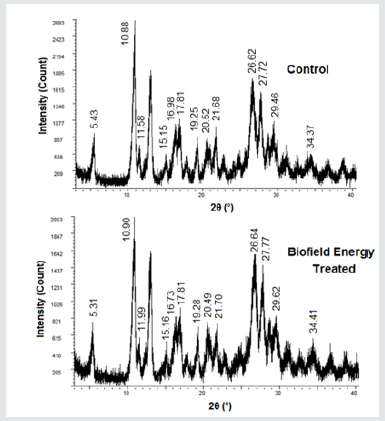
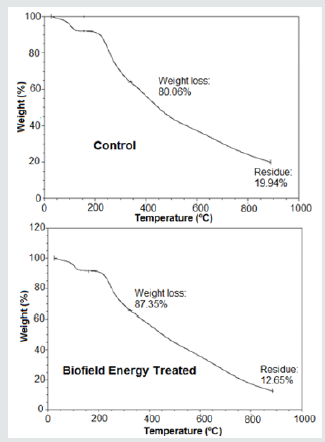
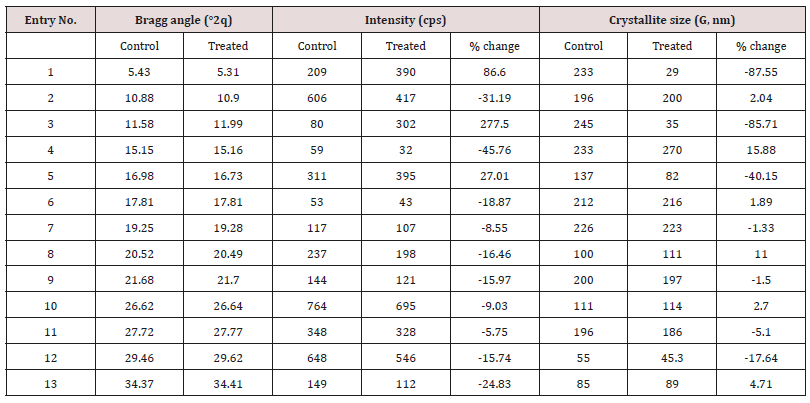
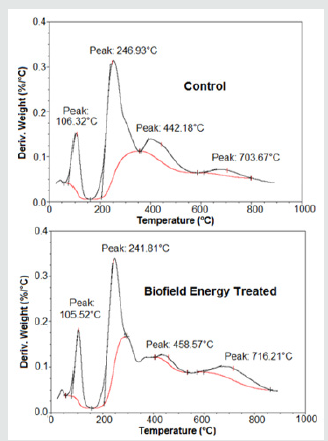
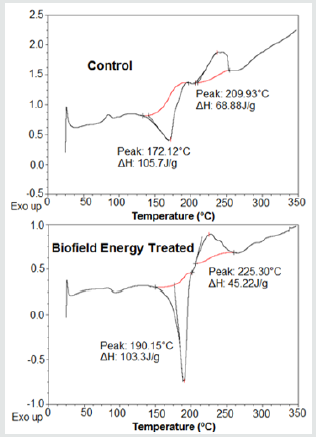
No comments:
Post a Comment
Note: only a member of this blog may post a comment.